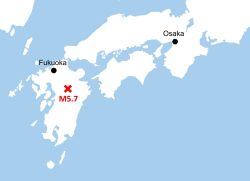Sushi Chains Giving Up Conveyor Belt; Some Switching to Touch-Screen Ordering to Reduce Waste, Improve Hygiene

A woman points at an item on a Digiro touch screen at a Sushiro outlet in Shinjuku Ward, Tokyo, in August.
13:52 JST, September 22, 2024
More and more conveyor belt sushi restaurant chains have abandoned the practice of serving sushi on a rotating conveyor belt. Some restaurants have introduced touch screens that present images of sushi dishes on a virtual conveyor belt.
The move is meant to prevent nuisance behavior by customers and to help reduce food waste.
Sushi chain operating companies are using digital videos and other methods to make the process of choosing one’s food more fun.
Industry leader Akindo Sushiro Co. has introduced a digital conveyor belt sushi display system called “Digital Sushiro Vision,” or Digiro. A large touch screen at each table at its restaurants displays the flow of sushi on video.
Customers can place orders by touching the screen, which displays recommended items as well.
The company says that the system has been well received since it was introduced at some Sushiro restaurants in September last year. The firm plans to increase the number of stores with this system to 19 nationwide by the end of this month.
A video of a customer licking the mouth of a bottle of soy sauce at a Sushiro outlet spread on the internet in 2023.
To prevent such troublesome behavior, Sushiro stopped using conveyor belts at all of its stores and switched to a system where customers use a touch panel to place their orders.
However, as Koichi Mizutome, president of Sushiro’s parent company Food & Life Companies Ltd., observed, “sushi moving along the belt is more lively.” Thus the firm decided to introduce the Digiro System.
“We want to balance reducing food loss and ensuring hygiene with the fun of getting to try new types of sushi,” a spokesperson for the company said.
Having sushi move along conveyor belts was a major draw for all of these companies’ restaurants. The problem was that it increased waste. For hygienic reasons, they would discard sushi that had been on the conveyor belt for a certain amount of time.
The sushi chains’ move away from the conveyor belt system also stems from changing consumer attitudes.
In a survey conducted by Maruha Nichiro Corp. this year, 81.5% of respondents said they ate more sushi prepared after ordering than sushi picked off of the conveyor belt.
Hamazushi Co., a firm under the umbrella of Zensho Holdings Co., has also stopped using conveyor belts at 90% of its outlets.
They have introduced a system which uses a linear high-speed track to deliver the ordered items to each table. The firm estimates that the new system will lead to a reduction in food waste of about 1,000 tons per year. Like Sushiro, some of its stores have installed video panels that allow customers to choose items.
Kura Sushi Inc., for its part, plans to keep the conveyor belt system in all of its restaurants, while also introducing order lanes. The company says it has reduced waste to about 3% by using artificial intelligence to analyze trends in what customers are choosing and thereby deciding what items to put on the conveyor belt. A company official said that there is a lot of demand, especially from foreign visitors to Japan, to experience conveyor-belt sushi as a part of Japanese culture. The company installed a 123-meter-long conveyor belt at its flagship store that opened in the Ginza district in Tokyo in April.
“Part of the essence of conveyor-belt sushi is the fun of picking items off the conveyor,” said conveyor-belt sushi critic Nobuo Yonekawa. “Sushi restaurants with no conveyor belts are efficient, and the number of such restaurants will probably increase in the future. However, if sushi restaurants do not come up with ways to make it fun, customers will drift away.”
"Society" POPULAR ARTICLE
-

M4.9 Earthquake Hits Tokyo, Neighboring Prefectures
-

Israeli Tourists Refused Accommodation at Hotel in Japan’s Nagano Pref., Prompting Protest by Israeli Embassy and Probe by Prefecture
-

M7.5 Earthquake Hits Northern Japan; Tsunami Waves Observed in Hokkaido, Aomori and Iwate Prefectures
-

Tsukiji Market Urges Tourists to Avoid Visiting in Year-End
-

M5.7 Earthquake Hits Japan’s Kumamoto Pref., Measuring Upper 5 Intensity, No Tsunami Expected
JN ACCESS RANKING
-

Keidanren Chairman Yoshinobu Tsutsui Visits Kashiwazaki-Kariwa Nuclear Power Plant; Inspects New Emergency Safety System
-

Imports of Rare Earths from China Facing Delays, May Be Caused by Deterioration of Japan-China Relations
-

Tokyo Economic Security Forum to Hold Inaugural Meeting Amid Tense Global Environment
-

University of Tokyo Professor Discusses Japanese Economic Security in Interview Ahead of Forum
-

Japan Pulls out of Vietnam Nuclear Project, Complicating Hanoi’s Power Plans
























